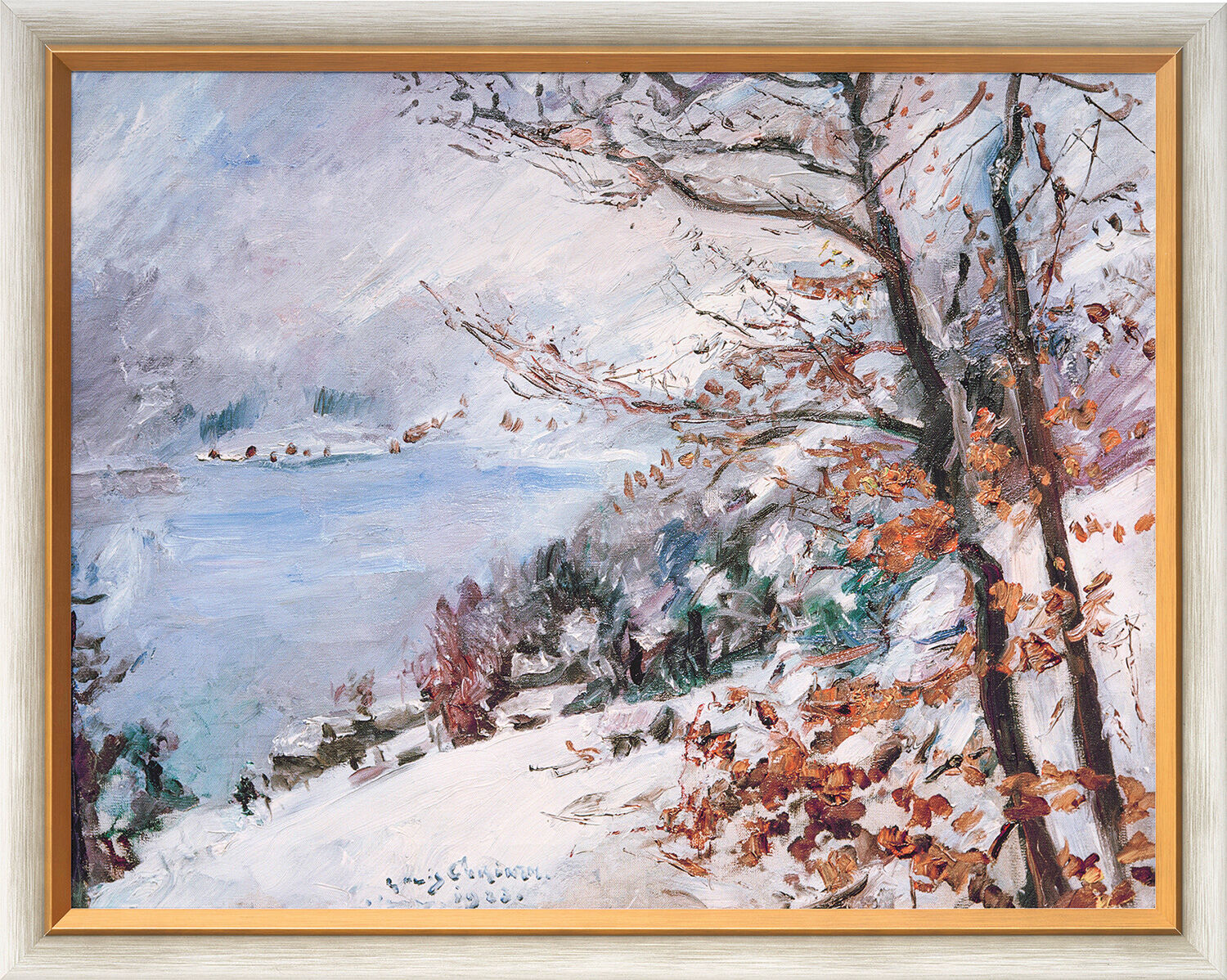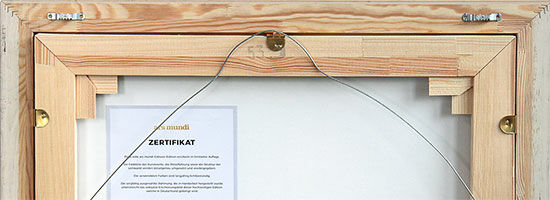Picture "Walchensee in Winter" (1923), white and golden framed version


Picture "Walchensee in Winter" (1923), white and golden framed version
Quick info
ars mundi Exclusive Edition | limited, 980 copies | numbered | certificate | reproduction, Giclée print on canvas | on stretcher frame | framed | size approx. 63.5 x 79.5 cm (h/w)
Video
Detailed description
Picture "Walchensee in Winter" (1923), white and golden framed version
From 1919 onwards, Lovis Corinth (1858-1925) found a retreat in Urfeld above Lake Walchen, which inspired him for numerous works of his late period. This is how his wife Charlotte Berend-Corinth describes how much the place impressed him: "Lovis was immediately gripped by the beauty of the landscape - by the magic of the Walchensee, the mountain scenery, the light and the air".
Original: 1923, oil on canvas, 70 x 90 cm, Städel Museum, Frankfurt am Main.
Edition transferred to artist's canvas in Fine Art Giclée process and stretched on a stretcher frame. Limited edition of 980 copies, numbered, with certificate. Framed in a handmade, white-golden solid wood frame. Size approx. 63.5 x 79.5 cm (h/w). ars mundi Exclusive Edition.
Frame configurator
Customised picture frame

Frame configurator
Customised picture frame






Customer reviews
Frame variant: Framing 1
About Lovis Corinth
"True art has no practical, utilitarian aftertaste. It exists solely for itself. Egotistical like a god, it stands before us in all its radiance." (Lovis Corinth)
The work of Lovis Corinth (1858-1925) is difficult to define as a whole. It is even questionable to classify his work as "German Impressionism" as opposed to French Impressionism - Corinth certainly experimented with the effect of colour in the sense of giving autonomy to the pictorial means. But he was mostly alien to scientific-academic calculations, colour systems or a justification of the effect of colour based on physics. In general, he opposed the artistic trends of his time and even scorned many of the new approaches of the young avant-garde as "formula art".
But at first glance, Corinth only appears to be a "conservative" painter. On the one hand, he remained attached to the figurative, realistic style of painting throughout his life. His sources of inspiration remained the old Dutch, above all Rembrandt, and he died near Amsterdam because he wanted to admire the originals there once more. However, on the other hand, he was regarded as a rebel and innovator, and always took the classical genres (history paintings, biblical and mythological themes) with a highly subjective eye, even to the point of parody and travesty. Thus, in the end, he was completely and utterly an outstanding contemporary of his artistic epoch and was perceived as such. He was modern in every respect anyway, and the series of his famous self-portraits show the sometimes-unstable Corinth, torn between artistic intoxication and depression, as a master of psychological self-interpretation.
Corinth's late work is of particular importance. First of all, there are the Walchensee pictures, which were painted near Urfeld in the south of Munich from 1919 onwards and in which the painter rediscovered landscape painting for himself. But he also sought and found new approaches in other subjects, such as portraits and still lifes.
Graphic or sculpture edition that was initiated by ars mundi and is available only at ars mundi or at distribution partners licensed by ars mundi.
Giclée = derived from the French verb gicler "to squirt, spurt".
The giclée method is a digital printing process. It is a high-resolution, large-format printout on an inkjet printer with special different-coloured dye- or pigment-based inks (usually six to twelve). The colours are fade-proof, i.e. resistant to harmful UV light. They have a high richness of nuance, contrast and saturation.
The giclée process is suitable for art canvases, handmade and watercolour paper as well as for silk.
The style of Impressionism, which emerged in French painting around 1870, owes its name to Claude Monet's landscape 'Impression, Soleil Levant'. After initial rejection, it began a veritable triumphal procession.
Painters such as Claude Monet, Edgar Degas, Edouard Manet, Auguste Renoir and others created motifs from everyday life, urban and landscape scenes in bright, natural light.
Impressionism can be seen as a reaction to academic painting. The emphasis was not on content with its strict rules of painting structure, but on the object as it appears at any given moment, in an often random cut out. The reality was seen in all its variety of colours in natural lighting. The Studio painting was replaced by open-air painting.
Through the brightening of the palette and the dissolution of firm contours, a new approach to colour emerged. In many cases, the colours were no longer mixed on the palette but side by side on the canvas so that the final impression lies in the eye of the viewer with a certain distance. In "Pointillism", (with painters such as Georges Seurat or Paul Signac) this principle was taken to the extreme.
Outside France, Impressionism was taken up by painters such as Max Slevogt, Max Liebermann and Lovis Corinth in Germany, and by James A. M. Whistler in the United States.
However, Impressionism was only expressed to a limited extent in the art of sculpture. In the works of Auguste Rodin, who is considered one of the main representatives, a dissolution of surfaces is evident, in which the play of light and shadow is included in the artistic expression. Degas and Renoir created sculptures as well.






